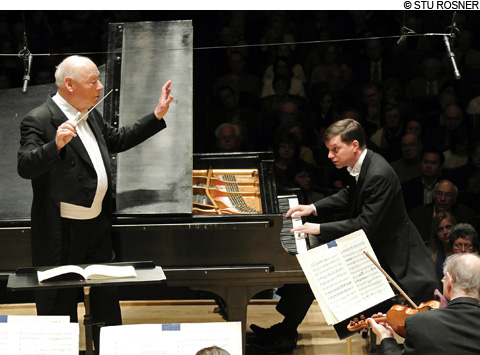
CONNECTING Conductor Bernard Haitink (here with soloist Till Fellner) and the BSO could leave you breathless with anticipation — or reading the program notes. |
Sometimes you know it the minute you hear it, sometimes it takes a while, sometimes it never happens at all. I mean with music: the way performers can seem instantly plugged into a score and connect it to you; or not. It could sound like a perfectly decent performance, yet it’s not getting to you — nothing happens.
I was feeling all these things in the last couple of weeks, especially at the BSO. Conductor emeritus Bernard Haitink, who just turned 83 and has been a BSO guest conductor for some 40 years, has led performances to which I’ve rarely felt connected. I keep hearing that the BSO players love working for him, and he mainly gets them to play beautifully. But the first of his three recent concerts seemed lifeless to me. So I was not expecting much from the second. The program was Debussy’s Prelude to the Afternoon of a Faun, with its languidly erotic flute solo; Mozart’s exquisite Piano Concerto in E flat, No. 22, with Till Fellner, a young Viennese pianist I’ve been eager to hear (at Haitink’s request, he interrupted his self-imposed sabbatical from playing in public); and yet another Beethoven symphony, No. 6, the familiar Pastoral.
I liked the wind playing in the Debussy (Elizabeth Rowe, flute; John Ferrillo, oboe), and I liked Fellner. He produces a crystalline sound with a delicate touch and a firm sense of line that feels natural, not effete. He was an ideal Mozart pianist. But Haitink never brought to the surface the profound mysteries of Mozart’s orchestral writing. The first movement of the Pastoral seemed so pedestrian I started reading the moving program note by Beethoven biographer Jan Swafford. But when the slow movement started, there was Beethoven! The “Scene at the Brook” had real presence. The players seemed to be visualizing — or hearing — the murmur of the water and the leaves rustling, to be meditating on the reality of this experience. The performance wasn’t exactly a revelation, but it made me glad to be there, listening to eloquent music-making. That continued through Beethoven’s violent “Storm” and final “Hymn of Thanksgiving.” It reminded me why I want to go to concerts.
Symphony Hall was sold out the following week for Haitink’s Beethoven Ninth, the BSO season closer. The Tanglewood Festival Chorus was in excellent if raucous form for the final movement, but the rest of the symphony had me reading the program notes again. Almost nothing clicked. Beethoven’s mysterious evocation of separate sounds that finally coalesce into a “symphony” (literally, sounds coming together) remained merely sounds, as did the rest of the movement. What Jan Swafford described as a “Dionysian” Scherzo seemed less a whirlwind than a march — militaristic, mechanical, joyless. The slow movement sagged. Bass soloist Günther Groissböck, strikingly stentorian, rallied the troops with Beethoven’s dismissal of all the music that came before and urged the chorus to turn to joyful song. Then the vocal quartet kinda faded into the background. Haitink whipped things up for a lively finale and got a standing ovation I couldn’t join.